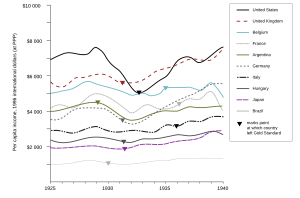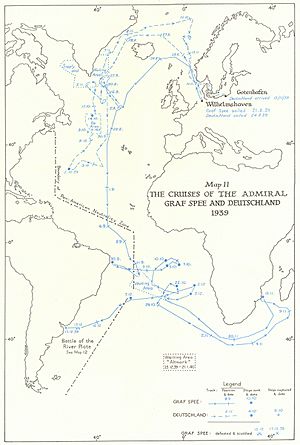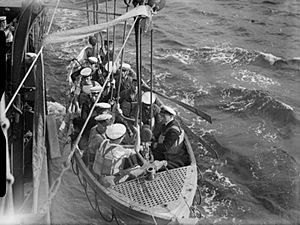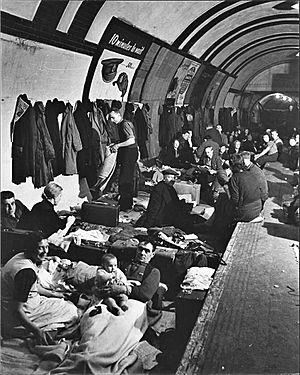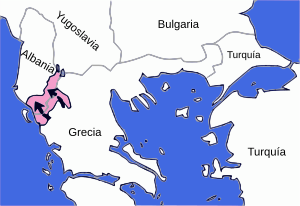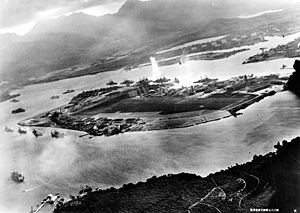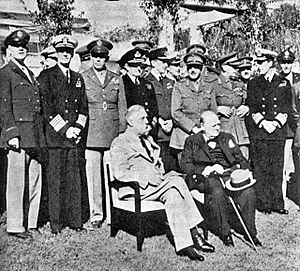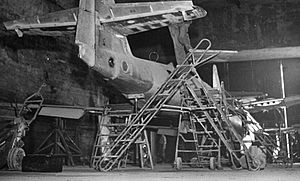Blockade of Germany (1939–1945) facts for kids
The Blockade of Germany (1939–1945), also called the Economic War, was a big effort during World War II. The British Empire and France worked to stop Nazi Germany (and later Fascist Italy) from getting important supplies. These supplies included minerals, fuel, metals, food, and textiles. Without them, Germany couldn't keep fighting.
This "economic war" mostly involved a naval blockade. This was part of the larger Battle of the Atlantic. But it also included bombing important factories. And the Allies bought war materials from neutral countries. This stopped those materials from being sold to the Axis powers.
The blockade happened in four main parts:
- First part (1939-1940): From September 1939 to the "Phoney War". Both sides tried to stop neutral ships carrying goods to their enemies. But Germany still got materials from the Soviet Union and through Spanish ports.
- Second part (1940-1941): After the Axis powers quickly took over most of Europe in 1940–1941. This gave them control of many factories and farms.
- Third part (1941-1944): Started in December 1941. The attack on Pearl Harbor brought the U.S. into the European war.
- Final part (1944-1945): The war turned against the Axis after big defeats like D-Day in June 1944. The Allies pushed the Axis out of occupied areas.
Contents
How the Blockade Started
Lessons from World War I
In First World War (1914), the United Kingdom used its strong navy to control shipping. Britain ruled the North Sea, Atlantic Ocean, and Mediterranean Sea. They also controlled the Suez Canal. This meant they could stop enemy ships.
Britain and France listed items neutral ships couldn't take to Germany. These included food, weapons, and raw materials like iron ore. They controlled 15 of 20 ship refueling points. So, they could threaten ships that didn't follow the rules.
Neutral ships were stopped and searched for illegal goods. The Dover Patrol and Tenth Cruiser Squadron guarded the North Sea. The Mediterranean was blocked at both ends. Large dreadnought battleships waited at Scapa Flow. Later, a huge minefield was placed between the Faroes and Norway.
Britain thought naval blockades were a fair way to fight. Germany relied a lot on foreign imports. The World War I blockade hurt them badly. Their own strong navy was stuck in its bases. Germany also used its U-boats to sink Allied merchant ships. This almost won them the war by 1917. But Britain used the convoy system to protect ships. The Allied blockade eventually led to Germany's defeat in 1918.
Getting Ready for World War II
In 1933, Adolf Hitler became Germany's leader. After Germany took over other lands, many thought a new war was coming. From 1937, Sir Frederick Leith-Ross, a British economic advisor, pushed for a new blockade plan. He wanted the Royal Navy to be ready to stop shipments to Germany right away.
Leith-Ross had worked in many countries. His plan was to update the World War I blockade. He wanted to use new technology and Britain's global business network. Contacts in cities like New York and Tokyo would gather information. Bankers, merchants, and ship operators would give tips. This would help the Navy know which ships might be carrying illegal goods.

At first, Prime Minister Neville Chamberlain hoped to avoid war. But after the Munich Agreement in 1938, he saw the need for war preparations. Britain and France quickly built up their armed forces. New Spitfire fighters entered service. New naval ships joined the fleet. The Chain Home radar network was made ready.
In April 1939, Britain and France agreed that economic warfare would be their main weapon. The Royal Navy's war plans had three key parts:
- Protect trade in British waters and the Atlantic to keep imports coming.
- Protect trade in the Mediterranean and Indian Ocean.
- Strongly blockade Germany and Italy.
Germany Before the War
Hitler had warned his generals about another war since 1934. Germany was worried about a new blockade. The World War I blockade had caused great suffering. Some say half a million Germans died from starvation. Germany also lost its navy after that war. New battleships like Bismarck were being built, but they weren't ready to fight the British and French navies.
Germany lacked natural resources. Its economy relied on importing raw materials to make goods for export. By 1900, Germany had Europe's biggest economy. But after World War I, it faced huge financial problems. There was hyperinflation and then the Great Depression. This led to Hitler taking power.
Hitler reduced unemployment by drafting men into the army and starting huge public projects like the Autobahn. But Germany's recovery was mostly fake. It had low foreign money reserves and no credit. So, Germany's economy was focused on war. They used clever financial tricks, like "Mefo bills," to pay for weapons. These were like IOUs that didn't show up in government budgets. Germany also made smart barter deals with other nations. They traded military skills and equipment for goods.
Hermann Göring led the effort to prepare German industry for war. In 1936, he started the Four Year Plan. Its goal was to make Germany self-sufficient by 1940. He built a huge industrial empire to make steel from low-quality German iron ore. He also moved important factories to safer central regions. Rivers were deepened, and canals were built to connect them.
Germany reduced imports to a minimum. Prices and wages were controlled. Trade unions were banned. Deals were made with countries like Sweden and Romania to stockpile vital materials. They also invested in "ersatz" (synthetic) industries. These made goods from resources Germany had, like textiles from cellulose and oil from coal. There were even fake foods like coffee from chicory.
An American journalist, William L. Shirer, noted shortages in Germany even before the war. Germany produced 85% of its own food. But rationing began a week before the war. People got one bar of soap a month. Housewives waited hours in line for supplies. Clothing allowances were tiny.
The Nazis said the Allied blockade was illegal. But they prepared to fight it. In May 1939, the German navy ordered that "fighting methods will never fail to be employed merely because some international regulations are opposed to them." This hinted at future unrestricted submarine warfare.
First Phase: The Start of the Blockade
Hitler invaded Poland on September 1, 1939. Britain and France declared war two days later. Hours later, the British ship Athenia was sunk by a German U-boat. This made the Royal Navy think unrestricted U-boat warfare had begun.
France and Britain worked closely together. A combined War Council was formed. The British army was put under French command. Parts of the French navy were under British command.
Many in Britain expected immediate bombing of cities. But when attacks didn't come, many people who had left cities slowly returned home.
Scapa Flow was again the main British naval base. But its defenses were old. On October 14, a U-boat snuck in and sank the battleship Royal Oak, killing over 800 sailors.
German "pocket battleships" like the Admiral Graf Spee were also a threat. They were designed to attack merchant ships. The Graf Spee sank British merchant ships in the southern Atlantic. Britain and France sent many ships to hunt down these raiders. The Graf Spee was eventually scuttled (sunk by its own crew) outside Montevideo, Uruguay.
Many German merchant ships were at sea when war broke out. About 30% hid in neutral ports. Others tried to sneak home or disguise themselves. But international law didn't allow selling ships in wartime. By Christmas 1939, at least 19 German merchant ships were scuttled by their crews.
Contraband Control
The British Admiralty announced that all merchant ships would be searched. This was done by the naval Contraband Control Service and the French Blockade Ministry. They didn't formally declare a blockade because of the suffering it caused in World War I. But they listed "contraband" (illegal goods) that would be taken. This included food, animal feed, clothing, and materials to make them. This was "Conditional Contraband."
"Absolute Contraband" included:
- Ammunition, explosives, and chemicals for war.
- All kinds of fuel and transport vehicles.
- Communication tools.
- Money and precious metals.
Britain set up three control points: Weymouth, The Downs, and Kirkwall in Orkney. Ships on other routes had to stop for detailed checks. Three more British control points were at Gibraltar, Haifa, and Aden. France helped control the Mediterranean. The Allies controlled the Suez Canal.
Customs officers and Royal Naval officers did the inspections. They had to be polite to neutral captains, especially from the Netherlands and Scandinavia. These countries had long traded with Germany. Control ports were often crowded. Officers checked cargo lists against import quotas. Neutral captains were amazed at how much Britain knew about their activities. Most stopped voluntarily at Allied control ports.
Ministry of Economic Warfare
The Ministry of Economic Warfare (MEW) coordinated the blockade. It was set up by Frederick Leith-Ross. He hired bankers, economists, and legal experts. Their job was to gather and check information from contacts worldwide. They passed relevant info to Contraband Control.
They also created a "blacklist" of companies that traded with Germany. Shipments from these companies were stopped first. One lesson from World War I was that middlemen could import goods into neutral countries and then send them overland to Germany. So, the MEW tracked how much countries bordering Germany normally imported. If they imported too much, pressure was put on them. Diplomats from Scandinavia, Italy, and the Balkans were given limits on how much they could import.
When a ship stopped at a control port, it raised a special flag. A team of officers would inspect the ship's papers. The wireless cabin was sealed. After checking, the ship's details were sent to the Ministry. If approved, the ship got a clearance certificate and special flags. These flags showed it had been checked. If something was suspicious, the cargo could be taken to a Prize Court.
In the first four weeks, Britain took 289,000 tons of illegal goods. France took 100,000 tons. Germany responded with its own blockade. They tried to stop neutral ships going to Allied ports. They targeted Norwegian, Swedish, and Finnish ships. Sweden even threatened to stop sending iron ore to Germany if attacks didn't stop. Germany also seized Danish ships carrying food to Britain.
By late September 1939, over 300 British and 1,225 neutral ships had been stopped. 66 had their cargo taken. These goods were often useful for the Allies. For example, 2 tons of coffee meant for Germany were seized.
Shipping Shortage
Germany had 60 U-boats at the start of the war. They were building more quickly. Britain had fewer destroyers than in World War I. Orders were placed for new, small escort ships called corvettes. Motor launches were used for coastal work. Later, larger frigates were built. Merchant ships were also armed for escort duty. French ships got ASDIC (sonar) to detect U-boats.
Building so many ships pushed British shipyards to their limit. New battleships like King George V were rushed to completion. French battleships were also rushed.
Aircraft carriers were used to escort unprotected ships. But this was risky. The carrier Courageous was sunk with many lives lost. There was a "Mid-Atlantic Gap" where convoys had no air cover. Churchill regretted losing the Southern Irish ports because Ireland stayed neutral.
In the first three weeks of the war, Britain lost 132,000 tons of shipping. By late September 1939, regular convoys were running. Britain also started talks with neutral countries like Norway to use their ships.
The blockade began to work. Allied sea and air power slowly cut off Germany's supplies. In the first week of October, Britain seized thousands of tons of petrol, sulfur, jute, textiles, and other materials.
Two months into the war, the Ministry brought back the "Navicert" system. This was like a commercial passport for goods. If a shipment had a Navicert, it meant it was not illegal. This allowed ships to pass control points without long delays. Ships without Navicerts could be seized. Countries that cooperated got "favored nation" status. Italy, though an Axis ally, was not yet in the war. Its captains used Navicerts for faster service.
U.S. Reaction to the Blockade
Passenger ships were also searched. Americans were angry that Britain opened all mail to Germany. By November 1939, 62 U.S. ships had been stopped, some for weeks. The U.S. State Department protested. The ship Manhattan was delayed at Gibraltar while British officers searched its mail. They removed 235 bags addressed to Germany.
Americans, who valued mail privacy, were upset. There were calls to use warships for mail. But the British claimed they found a U.S. conspiracy to send illegal goods to Germany through the mail. They refused to back down.
Gruss und Kuss (Greetings and Kisses)
Packages marked "Gruss und Kuss" (greetings and kisses!) were sent from the U.S. to Germany through neutral countries. These were advertised by "travel agencies" in German-language newspapers. One company sent 30,000 food packages in three months. The British said 17,000 of 25,000 packages they checked contained illegal food items, cash, diamonds, and maps. The U.S. government banned sending parcels through airmail after a ton of mail from a Pan American Airlines flying boat was taken in Bermuda.
Italian airlines also smuggled small items like diamonds. This stopped when British intelligence worked with the Brazilian government. The U.S. travel agencies and German consulates were closed in June 1941.
The "Phoney War" at Sea
During the early months of the war, called the "Phoney War", most fighting was at sea. News of the Contraband Control's successes boosted morale. In the first 15 weeks, the Allies claimed to have seized 870,000 tons of goods. This was 10% of Germany's normal yearly imports. It included millions of gallons of petrol and enough animal hides for 5 million pairs of boots.
Germany's preparations for war were much harsher than Britain's. Taxes on beer and tobacco went up. Income tax reached 50%. People had to do war work like filling sandbags. It became a crime to ask for a raise. New laws allowed harsh punishments for "Endangering the defensive power of the German people." Shirer noted that the blockade was already hurting Germany. It cut off 50% of its normal imports of nickel, cotton, tin, oil, and rubber. Germany now relied heavily on Sweden for iron ore.
Germany also looked to Romania for oil and the Soviet Union for other goods. The Nazi-Soviet Pact in August 1939 helped Germany economically. The Soviets provided refueling for German U-boats. They also accepted goods from America and sent similar amounts to Germany. However, actual trade only really began in 1940.
Germany kept up its aggressive sea strategy. By late 1939, they had sunk 249 ships. Many of these were neutral ships. Norway, Sweden, and Denmark lost many ships and sailors. Churchill was frustrated that neutral countries didn't side with the Allies. He believed they were trying to avoid angering Germany.
Churchill was especially bothered by the Swedish iron ore trade. Sweden sent 9 million tons of high-quality ore to Germany each year. This was vital for German weapons. In winter, Baltic ports froze. So, the ore went through the Norwegian port of Narvik. From there, it traveled through a hidden sea lane along the Norwegian coast. Germans used this "Norwegian Corridor" to stay in neutral waters, safe from the Royal Navy. Churchill wanted to mine this area to force German ships into the open sea. But Norway refused, not wanting to upset Germany.
By early October, the Allies felt confident about their blockade. Convoys were working. France claimed a third of German U-boats had been destroyed. Churchill said Britain had seized more illegal goods than it lost to torpedoes. In mid-October, Hitler ordered fiercer action from his U-boats and air force. He warned of a new "secret weapon."
Magnetic Mines
Hitler's "secret weapon" was the magnetic mine. These mines didn't need to touch a ship to destroy it. They were dropped by seaplanes in British harbors and channels. They had magnetic triggers. Many ships blew up in coastal waters. The new cruiser Belfast was badly damaged.
Britain worked fast to find a defense. They also prepared to rebuild the Northern Barrage. Chamberlain said Britain knew the secret of the magnetic mine. But more ships were sunk. Evidence showed Germany was using illegal floating mines.
Eventually, a method called degaussing was developed. This involved wrapping ships in electric cable to demagnetize them. Minesweeping methods were also improved.
Export Ban
From early December 1939, Britain stopped German exports. This was in response to the magnetic mines. Chamberlain admitted it would hurt neutral countries. But he said Britain's actions followed the law. Germany's mines caused deaths, but Britain's sea power did not. Before the war, 70% of Germany's exports went to Europe. The Ministry estimated that sea trade could be cut by 45%.
Germany accused Britain of sinking the Simon Bolivar. They told neutral ships to avoid British waters. They said British waters were military areas. All neutral countries protested. But this slowed neutral shipping to a halt. The Nazis later admitted the mines were German.
In Berlin, Shirer noted people rushing to buy goods to protect against inflation. The blockade meant a limited German diet, but people weren't starving yet. Restaurants were expensive. Pork and beef were rare. Coal was hard to get. Germany produced a lot of coal, but much was used to make synthetic rubber and oil. Germany was trying to export bicycles and cars without tires to get foreign money. German workers worked long hours, but many goods weren't available.
Some believed the blockade was so effective that Hitler would be forced to negotiate.
In early 1940, 60 German merchant ships were still in South American harbors. Hitler ordered them to try to get home. Few made it. Most were sunk or scuttled. The Germans preferred to sink their own ships than let the Allies capture them.
That winter was harsh. The Danube froze, slowing German imports from Romania. Britain made a deal with Spain to buy iron ore, copper, and lead. This helped Spain, which was facing famine, buy grain.
1940: Intensification
In January 1940, Ronald Cross, the Minister of Economic Warfare, said Germany was under similar economic stress as after two years of World War I. Germany couldn't afford a long war. They had little gold or foreign money. Imports had to be paid for by barter.
In February 1940, Germany and Russia signed a big trade deal. Germany would supply weapons and technology. Russia would supply grain, oil, cotton, and other goods. Hitler even ordered that goods for Russia should be prioritized over his own army.
As more U-boats joined the German navy, neutral shipping losses grew. Norway, Denmark, and Sweden lost many ships and lives. Admiral Raeder claimed Germany was allowed to use "similar methods" because the British blockade was illegal. He said British ships were legitimate targets.
Intensification of the Blockade
By spring 1940, Britain's optimism about the blockade seemed too early. Germany seemed to be getting more imports. Neighboring neutral countries continued to trade with Germany. Some, like Sweden, did it openly. Others secretly acted as middlemen.
Dutch traders were suspected of supplying copper, tin, and diamonds from America. Imports to the Netherlands, Norway, Sweden, and Switzerland increased. These were essential war materials.
The biggest hole in the blockade was the Balkans. Yugoslavia, Romania, and Bulgaria exported oil, chromium, and food to Germany. Germany also bought from Greece and Turkey. Britain tried to compete financially in these markets to deprive Germany of goods. But Germany paid high prices, often with military equipment.
Germany relied on Hungary and Yugoslavia for bauxite, used in aircraft production. Britain tried to stop this trade by blowing up the Iron Gate gorge on the Danube. But Romanian police stopped the plan. Balkan nations were pressured by Germany. Romania, a major oil producer, turned to Germany for protection from the Soviet Union. By May 1940, Romania was supplying half of Germany's oil needs.
The British Supreme War Council met in March to intensify the blockade. Britain bought Norway's entire whale oil surplus. They also made trade deals with Sweden, Norway, and other countries to limit materials to Germany.
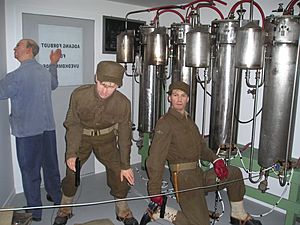
Chamberlain also said steps were being taken to stop Swedish iron ore. The Norwegian coast was mined in Operation Wilfred. The Special Operations Executive (SOE) was set up. This new organization provided intelligence and carried out sabotage. It helped identify targets for later bombing campaigns.
Bombing of Germany
After Germany invaded France, Britain began strategic air attacks on Germany. On May 11, 1940, the RAF bombed Mönchengladbach. On May 15/16, RAF Bomber Command attacked oil production and railway yards in the Ruhr district.
The Ruhr was a huge industrial area. It had many metal, chemical, and textile factories. It also had synthetic oil plants. Heavy smog made precision bombing hard. The Ruhr had strong air defenses. The early raids caused little damage.
Second Phase: Axis Control of Europe
Fall of France
France signed an armistice on June 24, 1940. Hitler now controlled most of Western Europe and Scandinavia. Germany set up new airfields and U-boat bases along the European coasts. They also occupied the Channel Islands.
German air forces attacked convoys in the English Channel. Cross-channel guns shelled the British coast. Hitler announced a blockade of the British Isles. He ordered preparations for an invasion of England, called Operation Sea Lion. Italy joined the war and set up a submarine base in Bordeaux. Mussolini announced a blockade of British ports in the Mediterranean.
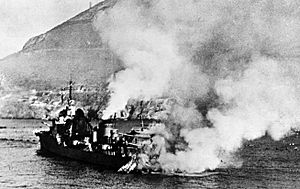
In Spain, General Francisco Franco resisted German pressure to join the Axis. Spain supplied Britain with iron ore. Franco saw that Britain was not defeated. The Royal Navy had weakened the German navy. The Luftwaffe lost the Battle of Britain. The Royal Navy destroyed much of the French fleet at Mers-el-Kébir and Italian battleships at Taranto. The British Army was beating the Italian army in Africa. Franco made demands Hitler couldn't meet.
American opinion changed after France fell. President Roosevelt had already negotiated "Cash and Carry" in September 1939. This allowed belligerents to buy weapons if they paid cash and handled delivery. This favored Britain, which had gold and a strong navy.
The U.S. increased its own defense spending. There was fear Britain would fall. The British army lost much equipment at Dunkirk. The U.S. sent old World War I rifles. After Britain attacked the French fleet at Oran to keep it from Germany, Roosevelt convinced Congress to support Britain more. They approved an order for 4,000 tanks.
With Germany closer to the European coastline, Britain moved its patrol ships to more urgent tasks. They closed some contraband control bases.
The Navicert system was expanded. "Compulsory Navicerts" and ship warrants were introduced. Any shipment without a certificate or ship without a Navicert could be seized.
Britain replaced lost Dutch and Danish food supplies with sources from Ireland and New Zealand. Canada had a surplus of wheat. Most Dutch and Belgian ships joined the British merchant fleet. The occupied countries and Vichy France were now under blockade. This caused severe shortages. The embargo was extended to all of France and its North African territories.
German Gains
During the Battle of France, Germany captured thousands of tanks, artillery pieces, and rifles. They also looted gold reserves and artworks from occupied nations. Trains were used to carry stolen machinery, books, and furniture to Germany. Later, even clothing and doorknobs were taken.
Germany also took the best food from conquered nations. Farmers were forced to sell their produce. An unfair exchange rate was set. German agents bought farms, factories, and mines. Central banks were forced to finance German plans.
Germany gained natural resources and industrial capacity. Austria and Czechoslovakia provided iron ore and heavy industry. Poland gave oil and zinc. Luxembourg had an iron and steel industry. Norway provided chromium, aluminum, copper, nickel, and molybdenum. It also allowed Swedish iron ore to be shipped from Narvik. The Netherlands had a tin smelter.
But France was the biggest prize. Its economy was forced to serve Germany's needs. France had to pay huge occupation costs. The occupied zone had France's best industries, including iron ore and steel production. Germany took 4,000 French locomotives and half of its freight cars.
Unoccupied France had rubber and textile factories and bauxite. This gave Germany plenty of aluminum. Germany now had enough metals and coal. But many factories worked at low capacity due to bombing and chaos.
Germany faced huge labor shortages. Occupied nations' workers were forced to work in factories or sent to Germany. Pre-war stockpiles ran low. More synthetic substitutes were used. Germany was cut off from overseas supplies like copper, nickel, tin, and rubber. Italy, an Axis partner, was also under blockade. Hitler's main problem was oil. Romania supplied some, and his synthetic industry produced more. Russia had huge oil reserves, but its extraction systems were underdeveloped.
Battle of Britain

Hitler's best chance to beat the blockade was to defeat Britain. Britain's navy enforced the blockade and kept supplies coming. Its empire provided resources and credit. British rationing was not as severe as in Germany. Only petrol was rationed at first. Food rationing became more widespread later in 1940. Britain relied on imports for much of its food.
Before the the Blitz (bombing of cities), German raids damaged southern British ports. So, maritime traffic was sent to the west and north. The Port of London was heavily damaged. But ships from the Empire and other countries continued to unload food and war goods. British aircraft factories worked hard to increase production.
The Luftwaffe focused on factories, ports, and airfields. On August 24, bombers accidentally hit central London. Churchill ordered the bombing of Berlin in retaliation. Berlin was bombed for the first time. Germans were shocked. Göring, who had promised it would never happen, was ridiculed. The Nazis then ordered the bombing of British cities to break morale.
The Battle of Britain raged in August and September 1940. But the Luftwaffe couldn't destroy the RAF. This was needed for an invasion. The RAF attacked German shipping and barges being gathered for the invasion. On October 12, the invasion was called off. But British cities were bombed for another six months.
European Food Shortages
Despite Germany's industrial gains, food was a problem. Europe couldn't feed itself even in peacetime. Germany now held much of Europe's farmland. But the occupied lands were a drain on their food resources.
Denmark produced a lot of food. But it depended on fertilizer imports from Britain. Livestock had to be slaughtered due to lack of feed. Farmers paid high taxes. The Netherlands also depended on Britain for animal fodder. Much farmland was ruined by floods. Meat shortages led to confiscating illegal dog-meat sausages.
Life was very hard in Poland. Thousands died from cold and starvation. Its crops were taken. Norway relied on imports for half its food. Belgium also suffered from food confiscation.
France, normally self-sufficient, had 5 million refugees. Germans took half a million horses and mules, hurting farm production. They also took 11% of food stocks. French prisoners of war were fed very little. Most items were heavily rationed. German soldiers got double rations, but it was still a modest diet.
The British blockade cut off 80% of Italy's imports. Food was severely rationed, leading to riots. After their disastrous invasion of Greece, Italy's supplies dwindled. Britain won a major victory against the Italian navy at Taranto in November.
Even the Balkans had food shortages due to a harsh winter. Romania, Hungary, and Yugoslavia were pressured by Germany for food.
In late 1940, Hitler wanted peaceful control of the Balkans. But after the Soviet Union took land from Romania, he invaded Romania in October. After Italy's invasion of Greece, Britain intervened. Hungary and Romania joined the Axis. Hitler now controlled vast agricultural resources and Romanian oilfields.
RAF Bomber Command continued to attack German targets. But it was hard due to long flights over enemy territory. After the German bombing of Coventry, the RAF raided oil refineries in Mannheim. This was the first "area raid." But most bombs missed. Still, bombing was the only hope to hurt the German economy. Roosevelt promised the U.S. would become the "Arsenal of Democracy," supplying Britain with weapons.
By late 1940, Europe faced severe hardship. Food supplies were down 15% due to the blockade and bad harvests. Starvation and diseases were a threat. Germany sent emergency supplies to Belgium and France. American charities sent aid. Former president Herbert Hoover warned of the greatest famine in history.
1941: Escalation
In early 1941, the war moved east. Mussolini asked for German help in the Greco-Italian War. Germany also sent the Afrika Korps to Libya to help Italy in North Africa. The British island of Malta was bombed daily. U-boat attacks on Allied merchant ships continued to rise. More foods were added to the rationed list in Britain.
In January 1941, Germany and the Soviet Union signed a "greatest grain deal in history."
Humanitarian Aid in Europe
In January, Herbert Hoover's committee proposed a plan to feed people in Belgium. Germany agreed to supply some grain. But Britain refused to let aid through its blockade. They argued it was Germany's job to feed conquered people. And that aid would indirectly help Germany's war effort.
Hoover said Belgian rations were very low. But Britain disagreed. Many Americans were appalled by the suffering. American charities sent food, clothing, and medical supplies to France. The American Red Cross sent "mercy ships" with milk and other supplies to France.
Some prominent Americans argued against sending food to France. They said French industry worked for Germany. And that Hitler had seized French wheat. They believed it would weaken the blockade. The U.S. government faced a moral dilemma. An economist, Karl Brandt, described how Hitler used food as a weapon. He gave more to soldiers and essential workers, and least to prisoners and Jews.
There were reports of Vichy French ships running the British blockade from North Africa. They ignored British orders to stop. Vichy Vice-Premier Admiral Darlan claimed the French merchant marine had brought through millions of bushels of grain and other foods.
Lend-Lease

America was determined to feed Britain. But Britain was facing financial strain. On March 11, 1941, Roosevelt and Congress passed the Lend-Lease program. This allowed vast amounts of war material to be sent to Allied countries. Churchill called it a "new Magna Carta." America was no longer completely neutral. Hitler ordered U-boats to attack U.S. vessels. This led to the first direct action between Germany and America in World War II.
Effects on South American Trade
The blockades severely impacted world trade. Many South American countries hoped to profit by supplying the war. But trade plummeted, and surpluses piled up. In February 1941, South American countries met to discuss improving trade among themselves. They agreed on measures to reduce reliance on overseas trade.
In America, some businesses suffered. But home producers benefited from less foreign competition. U.S. cheese-makers started producing substitutes for European cheeses. U.S. growers of tulips and other plants also saw prices double.
German Invasion of the Soviet Union
For the Nazis, taking over Russia would solve their raw material problems. On June 22, 1941, Germany invaded the Soviet Union. They caught the Soviets by surprise. They quickly took productive areas like the oilfields of Transcaucasia and the fertile "Granary of Russia," Ukraine. Ukraine produced much of Russia's wheat and other crops. It was also a major industrial region.
Russia had been a farming country. But Joseph Stalin's "Five Year Plans" modernized its industry. New industrial cities were built in Siberia and Kazakhstan. New oil wells were developed.
In the first six months, the Soviets were in disarray. They lost many men and much equipment. But they moved large parts of their industry east to the Urals and Siberia. This took time, but production eventually recovered.
On July 3, Stalin announced a "scorched earth policy." As Soviet forces retreated, everything that couldn't be moved east was destroyed. Factories, oil wells, crops, and animals were destroyed so Germans couldn't use them.
Allied Aid to Soviet Union
On August 2, 1941, Britain signed the Atlantic Charter with the U.S. They extended the blockade to Finland, which was fighting with Germany. Churchill now saw the Soviet Union as an ally. Britain sent arms to help Soviet industry. By mid-1942, Britain sent thousands of tanks and fighter aircraft via Arctic convoys.
America also provided significant support. The Alcan Highway was built to transport Lend-Lease equipment across Canada to Alaska. This linked up with air routes to the Soviet Union and China. The U.S. sent billions of dollars worth of goods, including tanks, trucks, jeeps, aircraft, steel, aluminum, petrol, and food.
The German attack on the Soviet Union led Britain to increase bombing. Oil targets remained a priority. Attacks on Hamburg, Bremen, and Kiel were successful. But attacks on rail targets in the Ruhr were costly due to German air defenses. The RAF suffered heavy losses.
Churchill promised to bomb Germany day and night. But Bomber Command was too weak for effective attacks. The planes were too small and carried too few bombs. Navigation was also faulty. The RAF was ordered to build up its forces for a spring offensive. New navigation aids and heavy bombers like the Avro Lancaster would be ready.
Third Phase: America Joins the War
On December 7, 1941, the Imperial Japanese Navy attacked the US Pacific Fleet at Pearl Harbor, Hawaii. They also invaded British possessions like Hong Kong and Singapore. The next day, America joined the war against Japan, Germany, and Italy. Japan, like Germany, lacked natural resources. Since 1931, Japan had become very nationalistic. It built up its military and conquered lands in Asia.
The world turned against Japan due to its actions. From 1938, America and Britain launched trade embargoes against Japan. They restricted oil, metals, and rubber supplies.
But sanctions didn't stop Japan. Japan signed the Tripartite Pact with Germany and Italy in September 1940. After the U.S. cut off 90% of Japan's oil supply in August 1941, Japan looked to the South Pacific for resources. Japan hoped to strike first, knock out the American fleet, and take over territories. They believed their enemies would eventually accept their new empire. Japan made stunning conquests in the region.
Blocking Japan was simpler because it was an island. It involved sinking transport ships carrying materials to Japan. This was mostly an American effort. Japan started with 6.1 million merchant tons. American submarines and aircraft slowly sank them. This constant loss of ships was a major reason for Japan's defeat. But the Allies agreed that defeating Germany would require more than just a blockade, including strategic bombing.
America Joins the Economic War
In December 1941, the United States joined the economic warfare system. The Board of Economic Warfare (BEW) was created. It was responsible for getting and producing all imported materials for the war and civilian economy. The U.S. created its own "blacklist" of pro-German companies. The United States Commercial Corporation made "preclusive purchases" of strategic materials. This supplied the Allies and prevented goods from reaching Germany.
American and British agencies worked closely. The American Embassy in London helped coordinate BEW activities in Europe. BEW staff worked with the MEW on Navicerts and contraband. They also developed new trade agreements. They tried to convince neutral countries like Portugal, Spain, Sweden, Turkey, Switzerland, and Ireland to stop trading with the Axis.
Portugal
Portugal's President, Antonio de Oliveira Salazar, was seen as pro-Axis. But he played both sides. Portugal supplied Germany with rice, sugar, tobacco, and other goods. Portuguese merchants also sent industrial diamonds and platinum. But the most important material was tungsten. Tungsten carbide was vital for heat-resistant steel, armor, and tools. Portugal was Europe's main supplier of tungsten.
Britain was Portugal's largest trading partner. Portugal allowed Britain credit. Germany was Portugal's second largest partner. Germany paid with consumer goods, and later with looted gold. Portugal also gave Germany generous credit. The Allies believed stopping tungsten sales would cripple German industry. They considered embargoes but hesitated. They also wanted access to Portuguese military bases in the Azores.
Spain
Spain suffered chronic food shortages. The Allies tried to keep Spain neutral. They limited its oil supply and made trade deals. Churchill told Roosevelt that Spain was near starvation. A U.S. food supply could keep Spain out of the war.
Spanish companies worked for Germany. Spain supplied Germany with mercury and tungsten. Spain was the world's second-largest tungsten producer. By 1943, Spain adopted a more neutral policy. The Allies bought tungsten to prevent it from reaching Germany. They again hesitated to use an oil embargo, fearing it would push Franco to join Germany.
Sweden
Sweden was Germany's main source of high-quality iron ore and ball bearings. The British tried to stop this trade from Narvik with Operation Wilfred. Allied experts believed that without Swedish exports, the war would stop. But Sweden was surrounded by Axis countries.
The U.S. and Britain understood Sweden's difficult position. Sweden made concessions to the Nazis, like exporting timber and iron ore. They also allowed Germans to use their railway system. But the Allies believed Sweden went too far. They disliked Sweden transporting German soldiers and war materials. The Allies offered to relax blockades to persuade Sweden to reduce aid to Germany. Churchill believed Sweden could help defeat Germany. After German defeats in 1943, Russia also urged Sweden to do more.
Turkey
Turkey signed a military alliance with Britain and France. But it remained neutral. It supplied both sides with war needs. Turkey began selling large amounts of chromite ore to Germany in October 1941. This was essential for chromium production. Germany paid with iron, steel, and manufactured goods. The U.S. bought chromite and other materials from Turkey. They also sent modern equipment to Turkey's armed forces. This helped maintain Turkey's neutrality. Turkey eventually ended trade with Germany and declared war in February 1945.
Argentina
The U.S. was frustrated with Argentina. Its government refused to cooperate with U.S. economic measures. It also kept financial ties with Germany. Argentina doubled its beef exports to the U.S. and Britain. But its government was openly pro-Nazi. German agents operated freely. Argentine merchants smuggled platinum and other chemicals to Germany. The U.S. tried to pressure Argentina to break ties with the Nazis.
Switzerland
Switzerland during World War II had a complex relationship with Germany. It stockpiled food and weapons. After Nazi conquests in 1940, Switzerland was surrounded by German-controlled lands. But Switzerland was more useful to Germany as a workshop. Switzerland traded with Germany to survive, mostly for coal. Swiss companies provided guns, transmitting equipment, and other goods.
Switzerland was subject to Allied blockade measures. In December 1941, Britain blocked a Swiss military purchase of cameras. The U.S. considered quotas for Swiss imports. Some Swiss firms were blacklisted for exporting to Germany.
Some Swiss individuals and companies supported the Nazis. They helped ship Nazi funds and hide looted art and gold. U.S. files showed a belief that neutrals trading with the Axis should face punishment. But the Allies decided against extreme measures due to Switzerland's humanitarian work. The International Committee of the Red Cross (ICRC) did valuable work, especially in Greece. Switzerland also gave asylum to refugees and Allied prisoners of war.
Switzerland eventually used up its food stockpiles. It suffered fuel shortages. It developed its own merchant marine to get imports.
1942: Turning the Tide
In early 1942, the Allies hadn't won a major victory. In February, Germany sank many ships in the Atlantic. Hitler was about to launch a huge offensive for the Caucasus oilfields. Albert Speer became head of the German Armaments Ministry. He organized resources well and increased production.
On February 14, Britain decided to use "area bombing" to hurt civilian morale. Air Marshal Arthur Harris became head of Bomber Command. The Lancaster bomber and new navigation aid GEE were finally ready.
The bombing campaign began in March. A "saturation raid" on the Renault factory near Paris killed many French workers. Raids on Essen were disappointing. Only one bomb in 20 fell near the town. A raid on Lübeck used incendiaries. Production was back to normal a week later. A daylight raid on the MAN diesel engine factory in Augsburg was costly and ineffective.
Thousand Bomber Raids
Faith in bombing was fading. Harris pushed for a mass raid with 1,000 bombers. On May 30/31, 1942, over 1,000 RAF bombers raided Cologne. Over half the city was destroyed, but it recovered quickly. RAF attacks on other German towns also did little to weaken the economy. From July, U.S. air forces began daytime precision bombing of German targets. They damaged the Heroya aluminum center in Norway. From mid-November, the RAF began mass night raids on Berlin. In 1942, the RAF dropped 37,000 tons of bombs on Germany.
On December 21, 1942, the USAAF attacked the Krupp plant in Essen. They aimed to paralyze German industry by focusing on key sectors. Another important target was ball-bearing factories in Schweinfurt. Speer and Erhard Milch realized the war was turning. On February 25, 1943, the Allies began round-the-clock strategic bombing. Bomber Command began the 5-month Battle of the Ruhr.
Blockade Runners
New supplies of oil, rubber, and tungsten from the Far East led to barter deals. Germany got these goods, and Japan got precision tools and ball bearings. By mid-1942, a system of fast blockade runners was set up. These freighters traveled non-stop to avoid detection. The MEW believed Japanese rubber reached Germany in summer 1942. They were concerned about the "steady trickle" of Japanese blockade runners.
Other blockade runners arrived at Bordeaux, France. This port was heavily defended. A naval attack was impossible. Bombing was too inaccurate. The "Bordeaux Problem" led to a different approach.
On December 7, 1942, Combined Operations launched Operation Frankton, the 'Cockleshell Heroes' mission. A 12-man team of Royal Marine Commandos paddled up the Gironde River in canoes. They aimed to place bombs on ships. The mission damaged some ships, but only 2 men survived. The others drowned or were executed.
The SOE was also planning to destroy blockade runners. But the commando mission ruined their preparations. Still, Allied air forces and navies eventually tracked down the blockade runners. By late 1943, Germany was desperate for supplies. They sent destroyers to protect ships coming into Bordeaux. But they lost three vessels. By May 1944, 15 blockade runners had been sunk. The traffic almost stopped.
Greek Famine
By early 1942, Greece, invaded by Germany and under blockade, faced famine. Its economy was ruined. Greece had to pay occupation costs and a "war loan." Food and raw materials were confiscated. Potatoes were fried in Greek olive oil and sent to Germany. An American correspondent said, "Germany worked like a pack of driver ants, picking Greece clean." The corrupt government controlled the black market, causing huge inflation. People died from hunger and disease.
In September 1941, Greece appealed for aid. Turkey sent wheat, maize, and medicines. But the ship sank. By January 1942, thousands were dying daily in Athens. Italy, occupying Greece, sent some grain. Eventually, international pressure forced Britain to lift its blockade. Britain and America sent wheat to Greece. The Greek Orthodox Church and International Red Cross distributed supplies. The famine killed at least 70,000 people.
By late 1942, Germany was reportedly paying with forged U.S. dollars. Spain refused to ship oranges until paid. Some neutral countries began to take a tougher stance with Germany.
1943: Continued Hardship
1942–43 was a bad year for French agriculture. Drought affected many regions. Germans confiscated 40% of the crop. The authorities took another 40%. Farmers were left with only 20%. Rain spoiled potato crops in some areas.
South of the Loire, the weather was better. But Germans stripped the land to leave nothing for the Allies. Hermann Göring said Germans had the right to take food from occupied peoples. Rationing was severe. The black market pushed prices very high. Restaurants served dishes without fat. Alcohol was confiscated for industrial use.
The MEW continued to refuse requests to relax the blockade. They believed any relaxation would be exploited by the enemy.
With more heavy bombers, Allied leaders trusted strategic bombing. But at the Casablanca Conference in early 1943, they decided that bombing cities to break morale didn't work. Instead, they focused on "disorganization of German industry." Synthetic oil plants in the Ruhr became the main target.
Fourth Phase: The Final Push
After German defeats at Stalingrad and El Alamein, the war turned. New destroyers and escort carriers closed the "Mid-Atlantic Gap" for convoys. U-boats were largely defeated by mid-1943. Germany's labor shortages grew severe. They relied on slave labor.
Sir Arthur Harris and Major General Ira Eaker believed Germany could be bombed out of the war by late 1943. Harris was known for his harsh views on German civilian deaths. He believed land forces would only occupy Germany after bombing defeated it. Allied land and navy commanders doubted bombing alone would win. But they agreed it would weaken Germany before the invasion. Only 10% of bombs hit their targets. But attacks on Germany's railway system seriously affected military operations.
On May 16–17, 1943, the RAF carried out the famous Dambusters raid (Operation Chastise). They breached the Mohne, Eder, and Sorpe dams. These supplied the Ruhr industries with power and water. The raid killed 1,500 people. On July 24, 1943, Hamburg was largely destroyed in Operation Gomorrah. Mass attacks killed 42,000 people.
The U.S. 8th Air Force was growing fast. On August 1, the USAAF attacked the Romanian Ploiești oilfields. This was part of the Oil Plan to reduce Axis oil supplies. Losses were heavy, but production wasn't stopped. On October 14, 1943, the 8th USAAF attacked the Schweinfurt ball-bearing works. This caused a temporary setback. This led to a rethink on bomber formations and daytime attacks.
German Requisitions Continue
After three years, Britain had spent £10 billion. The MEW believed German productivity was down 30% by late October 1943. But many factories continued to operate.
In early November, the MEW reported on what Germany had taken from occupied lands. They estimated over $12.8 billion had been taken in occupation costs. Poland was treated harshly. All state properties and central stocks were confiscated. 9,000 factories were taken over. 80% of the 1942 harvest went to Germany. Czechoslovakia lost its grain, gold, and industries. Belgium's gold reserves were surrendered. All cars in Yugoslavia were seized. In Norway, personal property was taken. In Denmark, Germans controlled all trade.
Troops also seized furniture for bombed-out German families. Under Albert Speer, factories were moved to Czechoslovakia. Despite damage to towns, war material output was higher than ever by late 1943.
1944: Invasion Approaches
By early 1944, it was clear bombing alone wouldn't win. Preparations for the invasion of Europe were underway. Spain, Portugal, and Sweden faced pressure to stop selling vital goods to Germany. Spain was still selling tungsten. The U.S. demanded a complete ban and reimposed an oil embargo. Spain agreed to reduce exports in May 1944. Portugal also defended its right to neutral trade.
Big Week
On February 20, 1944, the USAAF began Operation 'Big Week'. This aimed to weaken the Luftwaffe to gain air superiority for the invasion. For six days, aircraft factories were bombed. The RAF bombed the same targets at night. Damage was severe. But Speer managed to increase production again.
The Allies were slow to realize Germany's real weakness was oil supply. In early March, the USAAF attacked the Erkner ball-bearing works. The new objective was to halve Axis oil production.
On May 12, the USAAF hit East German synthetic oil plants. They were badly damaged. Speer later called this a turning point.
Sweden began to reduce trade with Germany. An agreement to end ball-bearing exports failed to include high-quality steel. So, it had little effect. Allied efforts to stop Turkish chromium sales worked. Speer said Germany's armaments would stop without Turkish chromium. Turkey ceased exports by April 1944.
Germany was losing sources of special metals. The Red Army took back manganese mines. Nickel from Finland and molybdenum from Norway were no longer available.
Eve of Overlord
In May 1944, just before D-Day, Lord Nathan said the blockade had saved Britain from defeat. It made victory possible and gave time to prepare. He said Germany was now "brittle." Lord Selbourne added that Germany's greatest lack was manpower. Germany relied on slave labor. In June 1944, Britain gained access to naval bases in the Azores. Portugal then imposed a complete embargo on tungsten exports to both sides.
D-Day
As D-Day approached, the Allies bombed Ploiești and artificial fuel sites. German air defenses couldn't protect them. Production dropped rapidly. From D-Day, the Allies controlled the skies over the beachhead. They transported oil via tankers and underwater pipelines. Artificial harbors helped bring supplies ashore.
German armies in Normandy couldn't get enough fuel for tanks. They were also forbidden to retreat. They suffered heavy shelling from Allied battleships. German commanders hoped new jet fighters and V-weapons would turn the tide. The first V1 flying bomb was launched against England in June 1944.
Allied Supply Problems
After D-Day, the Allied advance slowed due to supply problems. Getting supplies to forward troops was hard. Each division needed hundreds of tons of supplies daily. The speed of advance meant no time to build proper logistics. The "Red Ball Express" truck system helped. But in late August, the Allied advance stopped due to lack of fuel.
The Allies failed to capture a deep-water port. Germans destroyed all dock facilities as they retreated. By early September, only Antwerp in Belgium was undamaged. The SOE helped the Belgian resistance seize the port. Belgium was liberated quickly.
Supply problems also caused disagreements. General Dwight D. Eisenhower wanted to advance on a broad front. But he accepted British General Bernard Montgomery's Operation Market Garden plan. This plan failed and stretched supply lines further.
Loss of Balkan Ores
By early October, Germany's position worsened. Iron ore supplies were down 65% compared to 1943. Pig iron and steel production were also down. Copper supplies from Turkey and Spain were cut off. Germany lost contact with copper mines in Yugoslavia and Finland. Loss of Balkan mines took away chromium and reduced lead supply. Germany's bauxite supply was cut by 50%. Cobalt from Finland was down 80%.
Dutch Rail Strike
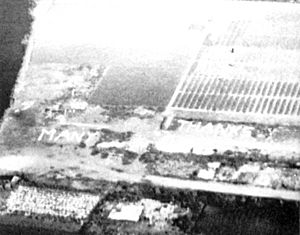
The exiled Dutch government called for a national rail strike to help the Allies. Germany retaliated by stopping food supplies to western Netherlands. This caused severe hardship. An early, harsh winter led to the Dutch famine of 1944. In the Balkans, the Ploiești oilfields were lost to Germany.
End of Swedish Trade
In August 1944, Sweden stopped iron ore exports to Germany. In November, all Swedish trade with Germany officially ended. Switzerland also agreed to cut sales of machine goods, ball bearings, and ammunition to Germany.
Attacks on German fuel installations were very successful. September's oil output was only 8% of April's. Supplies were exhausted. Allied air commanders then targeted German transport networks. The RAF breached the Dortmund–Ems Canal. The rail yard at Hamm was badly hit. On November 12, the battleship Tirpitz was sunk. By late 1944, Allied air power was unstoppable.
In late 1944, the German army launched the Ardennes Offensive. This was their last serious attempt to regain the initiative.
1945: The End Approaches
At the start of the war, Germany's transport system was excellent. But after autumn 1943, Allied bombing paralyzed much of it. The Ruhr became economically isolated.
The sustained Allied bombing of the transport network broke Nazi resistance. Speer admitted defeat in the armaments battle by early 1945. German industry couldn't keep up with weapon production. But many factories produced until Allied forces arrived.
V1 and V2 launch sites were being overrun. Refugees crowded cities. Food was a main priority. In February 1945, railheads and transport systems in over 200 small towns were attacked in Operation Clarion.
Safehaven Program
As the war ended, there were reports that Nazi leaders were hiding funds in neutral nations. They were preparing for the next war. German firms tried to sell patents to Swedish firms. Large chemical and electrical companies were getting foreign money to finance Nazi activities abroad. Food supplies were collected in the Alps for Nazi fortresses. Plans were made to transfer money to agents in neutral countries.
The U.S.-led Safehaven Program was launched in July 1944. It aimed to prevent the hiding of looted gold and assets. It also aimed to return looted items to their owners. Most neutral countries were convinced to stop trade with Germany.
The Swedish Government tightened exchange controls. But negotiations for the return of looted gold dragged on. Sweden eventually agreed to distribute over $66 million in German assets as reparations. Spain also acquired much gold from Germany. Spain agreed to return German assets.
Allied representatives wanted Swiss cooperation. Some Swiss companies secretly shipped explosives to Germany. German assets remained in Switzerland. Switzerland was the last country to fully commit to Safehaven. But due to its humanitarian record, the Allies decided against extreme measures.
After the War
After the war in Europe ended in May 1945, much of Europe was destroyed. Food, housing, and medical shortages continued. Millions of refugees were displaced.
In the U.S. and Soviet Union, productivity rose. In Russia, war production boosted industries. In America, rearmament brought idle industrial resources to life. The war changed the global economy. The U.S. gained a strong position.
Britain's economy was badly hit when Lend-Lease ended. Britain lost export markets. It faced a huge trade deficit. Rationing continued until 1953. Britain had to take a large loan from America.
In former occupied countries, severe inflation caused food prices to spiral. Low productivity was a problem. France expected German coal as reparations. But the U.S. realized Europe needed Germany's economy to restart growth. They refused reparations.
In Germany, people had to rebuild from almost nothing. West Germany's economy achieved a "Wirtschaftswunder" (economic miracle) within a few years. From 1951, France, West Germany, Italy, and the Benelux nations began moves towards European unification. They created the European Coal and Steel Community (ECSC). This aimed to coordinate critical supplies and prevent future wars.
The German synthetic-oil program was so advanced that it was reconsidered during the 1970s fuel crisis. Documents from the program helped engineers. Synthetic oils are now widely used in specialized areas.
Media Representation
In the early war months, the work of Contraband Control was big news. It boosted morale. News of German attacks and seized goods filled newspapers. Magazines like War Illustrated and Life showed photos and patriotic stories.
The blockade also appeared in films. Contraband (1940), starring Conrad Veidt, was set in a fictitious port. A Danish merchant captain is delayed by Contraband Control and meets enemy spies. It was Deborah Kerr's first film.
The Big Blockade (1942) was made by Ealing Studios with the Ministry of Economic Welfare. It showed how the British blockade was slowly hurting Germany's war effort. It starred John Mills, Leslie Banks, and Robert Morley.
Images for kids


